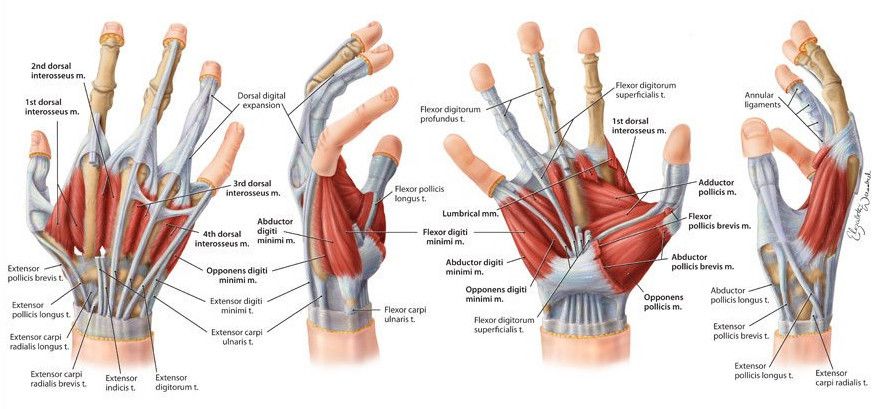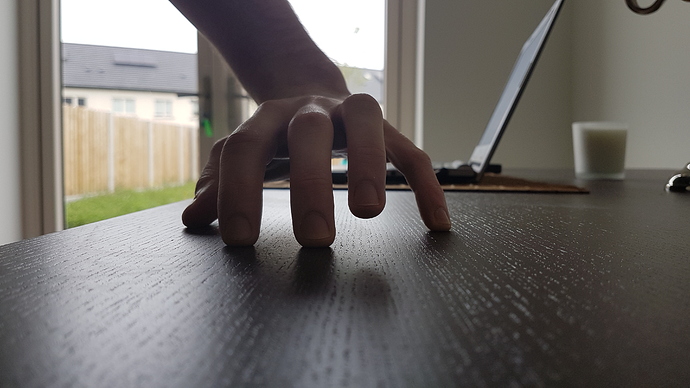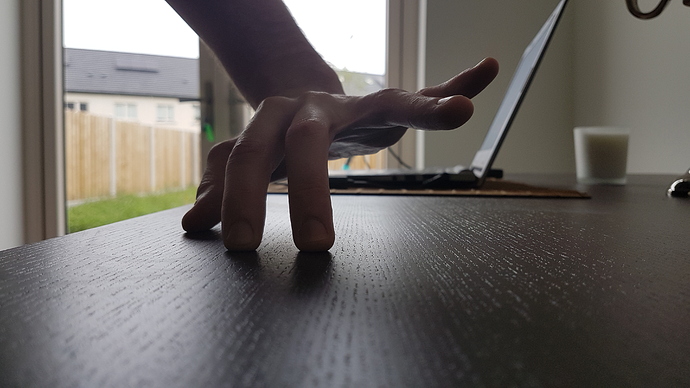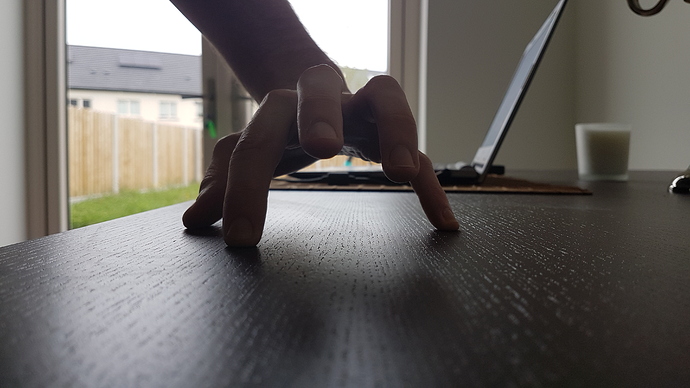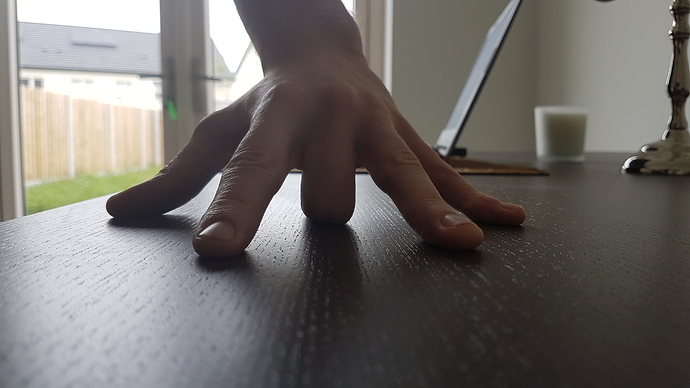I have been preparing a post about the left hand postures and fretting strategies I use in my playing, after reading through the following thread:
That promised post is still in preparation, and I will present it when I’m satisfied with it.
In preparing that post, I watched through several instructional videos and CTC interviews again.
While re-watching Shawn Lane’s Power Licks for the first time in a while, I realized something about his fretting sequences that I felt was extremely interesting, and which I’d like to share here. I have other observations regarding his picking which I’ll discuss elsewhere.
The concept I’d like to share here is something I’ve decided to call an Efficient Digital Cycle. Before I go in depth about it, I’d like to draw an analogy with something the community here is familiar with, being alternate picking and the problem of string-hopping.
An efficient alternate picking cycle requires that the downstrokes and upstrokes use antagonistic muscles. With a string-hopping movement, the upstroke and downstroke use the same muscle to escape the strings. The result is a much lower potential speed, and increased fatigue and strain in the picking hand. Making the string-hopping movement smaller doesn’t fix the problem.
I’ve long been critical of the idea of economy of movement. Making an inefficient movement smaller does not make that movement efficient, and focusing on making small movements is detrimental to learning to make efficient movements.
The idea is not an economy of movement, where we determine cost whether a movement is large or small, but an economy of movements, where we acknowledge that there is an abundance of different movements available to us, with different costs, in different currencies, and we endeavor to achieve our goals using a movement which is inexpensive to us in terms of the currencies we have available at that time. Cheap for gold is still expensive for silver.
So, with that in mind, let’s consider fretting cycles. A fretting cycle is a repeating sequence of fretting digits. The cycle length is the number of notes that it takes for the cycle of fretting digits to repeat.
For example, consider the following exercise. We play with one finger per fret (on any string) and repeat
-5-6-5-7-5-8-6-7-6-8-7-8-(repeat)
Here, we have a cycle of length 12;
(1 2 1 3 1 4 2 3 2 4 3 4)
As another example, we have the following A minor pentatonic scale, played with the first and third fretting fingers only
---------------------5-8-
-----------------5-8-----
-------------5-7---------
---------5-7-------------
-----5-7-----------------
-5-8---------------------
The fretting sequence here is
(1 3)(1 3)(1 3)(1 3)(1 3)(1 3) or (1 3)^6
That is, we have a cycle of length two played times. Consider the typical G major scale
-------------------------------5-7-8-
-------------------------5-7-8-------
-------------------4-5-7-------------
-------------4-5-7-------------------
-------3-5-7-------------------------
-3-5-7-------------------------------
There are multiple ways this sequence can be fretted, the two most common are
(1 2 4)(1 2 4)(1 2 4)(1 2 4)(1 3 4)(1 3 4) or (1 2 4)^6*(1 3 4)^2
and
(1 2 4)(1 2 4)(1 2 4)(1 2 4)(1 2 3)(1 2 3) or (1 2 4)^6*(1 2 3)^2
A cycle need not carry a specific starting digit, so we have equivalant fretting cycles
(1 2 3) = (2 3 1) = (3 1 2)
and
(3 2 1) = (2 1 3) = (1 3 2)
but
(1 2 3) =/= (1 3 2)
Now, let’s consider efficiency.
It is more expensive to transition between the 3rd and 4th fingers in a fretting sequence than between any other combination of two fingers. There are two primary anatomical reasons for this.
The first is that the 3rd and 4th fingers share common tendon and muscle attachments, and so the degree of independence possible between these two fingers is simply not at same level as the level of independence possible between the other combinations.
The other reason is that these fingers differ significantly in length, which makes it difficult to achieve a fretting posture where both fingers work together and work equally well with the 1st and 2nd fingers.
While it is possible to do this movement quite quickly, it quickly results in fatigue and strain. Transitions between the 3rd and 4th fretting fingers are to fretting cycles what string-hopping is to the alternate picking cycle.
The other class of movements which are expensive are transitions from one starting finger to another and then to fret a new note with the starting finger. For example, in the example of the pentatonic scale, the 1st finger needs to lift off from the the starting string and immediate fret a note on the next string while the 3rd finger is fretting, and vice-versa. For this reason if a, b and c represent fretting fingers, the fretting sequence
a b a
is more costly than
a b c
unless the latter contains a transition between the 3rd and 4th fingers, as noted above. There is is a subtle point here, which I’ll go into more detail on later.
Shawn overcomes the issue of transitioning between the 3rd and 4th fingers by not doing it. Shawn almost never used the (1 3 4) or (1 4 3) fretting sequences in his playing. Instead, he re-fingered patterns to avoid these sequences entirely. These sequences appear only when it’s unfeasible to re-finger the sequence, and even then, their appearances are brief.
The other class of expensive movements is avoided in his diatonic playing by the efficient cycling of the fingers.
Consider the fretting cycle (1 2 4) repeated. After the 1st finger frets, it has two notes duration to lift from it’s original position and fret a new note, and similarly for the other two fingers. That is, in this cycle, the next finger to fret is always cheap, and so this cycle is maximally efficient.
We find that there are four such maximally efficient cycles. Namely
(1 2 3), (3 2 1), (1 2 4), (4 2 1).
In Shawn’s playing, we can essentially consider the 3rd and 4th fingers as one, since they are almost never used in combination. So we’re left with only two such maximally efficient cycle types, (1 2 3) = (1 2 4) and (3 2 1) = (4 2 1).
For reasons I’ll discuss later, it’s wrong to consider one of these as an ascending cycle and the other as a descending cycle. Bother can be used ascending or descending, as we’ll see momentarily. Instead, I’ll call (1 2 3) & (1 2 4) the forward cycle, and (3 2 1) & (4 2 1) the back cycle. We can transition between both forward cycles cheaply and between between both back cycles cheaply. Transitioning between forward an back requires a turnaround, which has to be handled in a specific manner.
Amazingly, Shawn’s vocabulary of fast licks is almost entirely developed based on these two fundamental cycles. The notable exception is his pentatonic sequences, which he doesn’t play as fast.
What might be surprising about this economy of fretting movements is that costs are not massively altered by stretches, position shifts, string changes or even string skips. This allowed Shawn to develop an expansive vocabulary of patterns based on repetitions of these basic cycles, which he could then transition between easily.
Let’s consider some specific examples.
First, classic descending fours.
-9-7-6---7-6-----6-------|-------------------------|
-------9-----9-7---9-7-6-|-9-7-6---7-6-----6-------|
-------------------------|-------9-----9-7---9-7-6-|
-------------------------|-------------------------|
-------------------------|-------------------------|
-------------------------|-------------------------|
The fretting sequence here (recalling that the 3rd and 4th fingers are equal) is
(4 2 1)(4 2 1)(4 2 1)(4 2 1)(4 2 1)(4 2 1)(4 2 1)(4 2 1) = (4 2 1)^8
That is, each instance of the fours pattern consists of 4 instances of the back cycle.
Consider the signature lick where Shawn alternates between groups of four and groups of five
-9-7-6---7-6-------|-------------------|
-------9-----9-7-6-|-9-7-6---7-6-------|
-------------------|-------9-----9-7-6-|
-------------------|-------------------|
-------------------|-------------------|
-------------------|-------------------|
The fretting sequence here is
(4 2 1)(4 2 1)(4 2 1)(4 2 1)(4 2 1)(4 2 1) = (4 2 1)^6
That is, each combination of four and five consists of three instances the back cycle.
For sixes, we’ll first consider the descending version
-9-7-6-------|-------------|
-------9-7-6-|-9-7-6-------|
-------------|-------9-7-6-|
-------------|-------------|
-------------|-------------|
-------------|-------------|
The fretting sequence for each group of six is two instances of the back cycle. Ascending, we have
-------------|-------------|
-------------|-------------|
-------------|-------------|
-------------|-------6-7-9-|
-------6-7-9-|-6-7-9-------|
-6-7-9-------|-------------|
The fretting sequence is then
(1 2 4)(1 2 4)(1 2 4)(1 2 4) = (1 2 4)^4
That is, each group of ascending six is two instances of the forward cycle.
Let’s now how Shawn takes these cycles and expands upon them to attain his vocabulary. As a first example, Shawn took some descending patterns and made them ascend.
Ascending with the descending fours pattern (back cycles)
-------------------------|-------------------------|
-------------------------|-------------------------|
-------------------------|-------------------------|
-------------------------|-9-7-6---7-6-----6-------|
-9-7-6---7-6-----6-------|-------9-----9-7---9-7-6-|
-------9-----9-7---9-7-6-|-------------------------|
Ascending with the descending sixes pattern (back cycles)
-------------|-------------|
-------------|-------------|
-------------|-------------|
-------------|-9-7-6-------|
-9-7-6-------|-------9-7-6-|
-------9-7-6-|-------------|
Descending with the ascending sixes pattern (forward cycles)
-------6-7-9-|-------------|
-6-7-9-------|-------6-7-9-|
-------------|-6-7-9-------|
-------------|-------------|
-------------|-------------|
-------------|-------------|
Where this get’s really interesting however, is where Shawn changes incorporates more string changes within the cycles
-7-9-6-7---6-|-------------|
---------9---|-7-9-6-7---6-|
-------------|---------9---|
-------------|-------------|
-------------|-------------|
-------------|-------------|
This is the forward cycle, starting with the 2nd finger. Similarly, we have the following ascending pattern
-------------|-------------|
-------------|-------------|
-------------|-------------|
-------------|---------6---|
---------6---|-7-6-9-7---9-|
-7-6-9-7---9-|-------------|
This is the back cycle, starting with the second finger.
Next, we have Shawn’s descending triads.
-6-----------------
---7---7-----------
-----9---8---6-----
-----------9---8---
-----------------9-
-------------------
The fretting sequence here is
1 2 4 1 2 3 1 2 3
This is three instances of the forward cycle. The change from using the 4th finger in the first instance to the 3rd in the later instances is not difficult.
Let’s expand further. Let’s change string on every note within the pattern:
-9---6---7---|-------------|
---7---9---6-|-9---6---7---|
-------------|---7---9---6-|
-------------|-------------|
-------------|-------------|
-------------|-------------|
which is the back cycle, and
-------------|-------------|
-------------|-------------|
-------------|-------------|
-------------|---7---6---9-|
---7---6---9-|-6---9---7---|
-6---9---7---|-------------|
which is the forward cycle.
There is one other highly efficient fretting movement, which is to lift a higher finger off to a lower finger which is already fretted (except 4th to 3rd). That is the sequences
1 2 1, 1 3 1, 1 4 1, 2 3 2, 2 4 2
where in each case, the lower finger is held throughout the duration that the higher finger is fretting.
We notice that the turnaround
-------6-7-9-7-6-------|
-6-7-9-----------9-7-6-|
-----------------------|
-----------------------|
-----------------------|
-----------------------|
from the forward to the back cycle is efficient, provided that the second finger holds the fretted note throughout the movement of the 4th finger.
The opposite turnaround
-----------------------|
-----------------------|
-----------------------|
-----------------------|
-9-7-6-----------6-7-9-|
-------9-7-6-7-9-------|
from back to forward is is less efficient, but can be performed at high speeds provided we fret the same note with the 2nd finger before and after the note fretted by the 1st finger.
The efficiency of the lift to a lower note that is already fretted explains why the classic 6 note pattern is efficient.
-9-6-7-9-7-6-
The fretting sequence is
4 1 2 4 2 1
The note fretted by 2nd finger is maintained thoughout the duration of the following note fretted by the 4th, so the lift back to the 2nd finger is efficient.
Finally, I’ve decided to refer to the cycles as Efficient Digital Cycles rather than Efficient Fretting Cycles for a simple reason; I’ve noticed that they also appear in finger picking and hybrid picking patterns.
I hope this was interesting to read.





